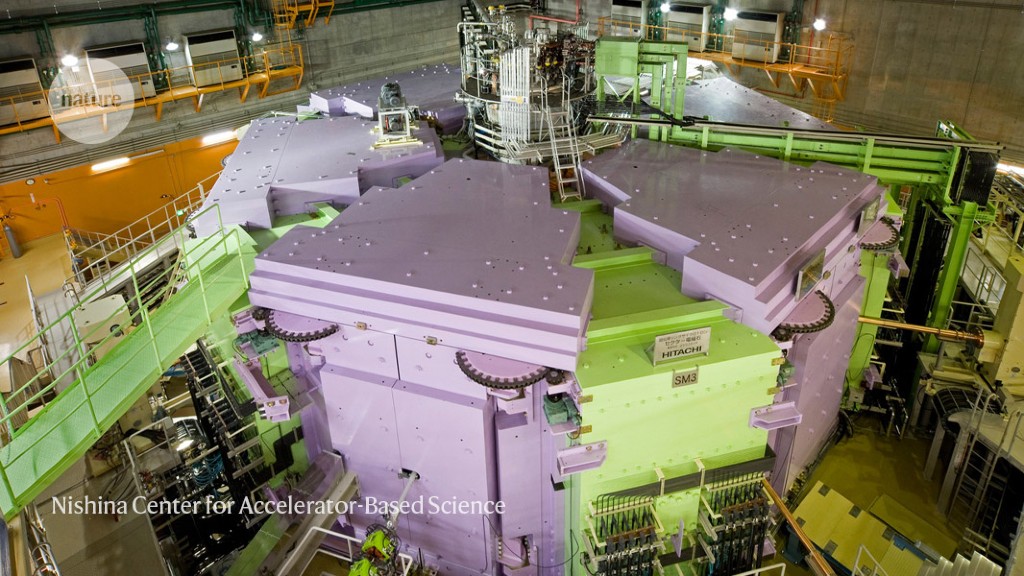Rare oxygen isotope detected at last — and it defies expectations

Oxygen-28 might prompt physicists to revamp theories of how atomic nuclei are structured

The Riken RI Beam Factory in Wako, Japan, creates streams of radioactive isotopes with help from this superconducting ring cyclotron.Credit: Nishina Center for Accelerator-Based Science
By combining a powerful set of instruments with some experimental savvy, physicists have for the first time detected oxygen-28 — an isotope of oxygen that has 12 extra neutrons packed into its nucleus. Scientists have long predicted that this isotope is unusually stable. But initial observations of the O28 nucleus suggest that this isn’t the case: it disintegrates rapidly after creation, a team reports in Nature today1. If the results can be replicated, physicists might need to update theories of how atomic nuclei are structured.
The strongest force in the Universe is the one that holds together the protons and neutrons in an atom’s nucleus. To unlock how elements are forged, the physics of neutron stars and more, scientists need to better understand this strong nuclear force, says Takashi Nakamura, a physicist at the Tokyo Institute of Technology. He and other researchers are testing theories about how atomic nuclei are held together by pushing them to extremes. One popular way is to load lightweight nuclei, such as oxygen, with excess neutrons and see what happens.
Current theories state that atomic nuclei with certain numbers of protons and neutrons are inherently stable. This is because protons and neutrons fill up ‘shells’ in the nucleus. When a shell is filled with just the right number of protons or neutrons, it becomes massively difficult to add or take away particles. These are ‘magic’ numbers, and have been thought to include 2, 8, 20, 28, 50, 82 and 126 particles. If a nucleus has a magic number of both neutrons and protons, it becomes ‘doubly magic’ — and therefore even more stable.
The most abundant form of oxygen, O16, is doubly magic, because of its eight protons and eight neutrons. Oxygen-28, with 8 protons and 20 neutrons, has long been predicted to be doubly magic, too. But physicists have not been able to detect it before.
Ghost hunters
Observing O28 required several experimental feats. Key to the whole operation were the intense streams of radioactive isotopes produced by the Riken RI Beam Factory in Wako, Japan. The scientists fired a beam of calcium-48 isotopes at a beryllium target, which created a fluorine-29 isotope. The nucleus of this isotope has one more proton than does O28 but the same number of neutrons. The scientists next smashed F29 into a thick barrier of liquid hydrogen, knocking a proton out of the nucleus and generating O28.
A large international team of researchers used instruments at the Riken RI Beam Factory to detect oxygen-28.Credit: Yosuke Kondo
This rare form of oxygen was too short-lived to be observed directly. Instead, the team detected its decay products: oxygen-24 plus four neutrons, a measurement that seemed impossible only a few years ago.
Measuring up to two neutrons at the same time has been done, but this is the first time scientists have detected four simultaneously, Nakamura says. “They are like ghosts,” he says of neutrons. With no electrical charge, neutrons can’t be wrangled in the same way that protons can (O24, with its eight positively charged protons, could be ushered into a detector with magnets). To observe individual neutrons, the team used a powerful detector built for that purpose, on loan from the GSI Helmholtz Centre for Heavy Ion Research in Darmstadt, Germany, in addition to Riken’s instruments. In this specialized detector, incoming neutrons are revealed when they knock protons around. Nakamura says that the study’s lead author, Tokyo Institute of Technology physicist Yosuke Kondo, used simulations to help to verify these tricky measurements.
“They’ve really done their homework,” says Robert Janssens, a physicist at the University of North Carolina at Chapel Hill. “They did all the checks you could do. It’s a tour de force.”
Atomic limits
Although the team wasn’t able to get an exact measurement of the lifetime of O28, Nakamura says that the isotope did not behave as if it were doubly magic — it fell apart almost as soon as it came into existence.
“I was surprised,” he says. “Personally, I thought it was doubly magic. But this is what nature says.”
This is not the first hint that nuclear physicists’ list of magic numbers is not universally applicable, says Rituparna Kanungo, a physicist at Saint Mary’s University in Halifax, Canada. She was part of a team of scientists that showed in 2009 that O24 — contrary to the nuclear rulebook — has a nucleus that behaves as though it is doubly magic2. Its 8 protons and 16 neutrons are strongly bound to one another, giving it a relatively long lifetime — it takes about 61 milliseconds for half of the O24 to disappear through radioactive decay. This means that in some nuclei, if they are strongly bound, 16 could be a magic number, too.
“Magic numbers are not immutable,” Janssens says.
For now, the confounding qualities of O28 raise a whole host of questions about the forces that hold nuclei together. Physicists are daydreaming about possible next steps. Nakamura wants to see whether it’s possible to detect oxygen-30. Because the stability of different isotopes is a relative measurement, it would be helpful to compare O28 with this heavier, yet-unseen, near neighbour.
“It’s so simple and so complicated,” Janssens says. “We don’t know at the moment how many protons and neutrons you can put together in a nucleus” and have them stay bound together, he adds. “In other words, what’s the limit?”
doi: https://doi.org/10.1038/d41586-023-02713-3
Read the related News & Views: ‘Heaviest oxygen isotope isfound to be unbound’
This story originally appeared on: Nature - Author:Katherine Bourzac


















